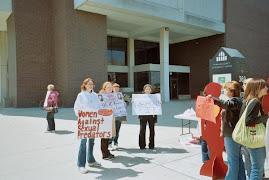PANAMA CITY
A worried mother wrote to Bay County Commissioner Mike Thomas, concerned about the sexual offender and predator ordinance proposed for unincorporated areas of the county.
Though the state requires sexual offenders and predators to live at least 1,000 feet away from places where children gather, all eight Bay County municipalities have increased the specified distance to 2,500 feet within the last couple of years. County officials are considering the same.
In the Feb. 26 letter, the mother recounts how her 20-year-old son had a sexual relationship with his 15-year-old girlfriend, whom he met at church, and subsequently spent eight years behind bars.
On Feb. 1, Justin Geiger was released into society. Finding himself effectively zoned out of local municipalities, he now lives in an RV in the unincorporated area of Bay County.
“I will never be able to live a normal life,” Gieger said. “It’s like a joke on me; you’re free, but you’re not really free.”
But Gieger doesn’t consider himself a “sexual deviant.” Such cases have given Thomas pause as he considers Bay County’s proposed ordinance.
“The more I dig into this and the more I find out about this, I’m more undecided about changing things,” Thomas said. “It’s a lot more complicated than it looked when it was first handed to me.”
The commissioner said he fears someone caught urinating in public or “mooning” someone, or “kids that have done crazy things” might be unfairly labeled as an “offender” and be subject to such ordinances.
“They’re not a danger to the community,” Thomas said. “I’m not comfortable penalizing people who aren’t a danger to anybody.”
The County Commission is considering the local ordinance upon a request from Bay County Sheriff Frank McKeithen, who made the request last year of all local governing bodies.
“He feels ordinances like this work best when they’re uniform,” said Ruth Sasser, spokeswoman for the Sheriff’s Office.
Lynn Haven adopted such an ordinance last year. City Manager John Lynch said at the time that offenders could be pushed into the city because of 2,500-feet-ordinances in surrounding municipalities.
“We’re not a haven for sexual predators,” Lynch said.
State Attorney’s Office spokesman Joe Grammer said local sexual offender ordinances have become fashionable lately. There are not many people, he said, willing to carry the banner against such regulations.
“It makes you look like you’re being tough on those guys,” Grammer said.
Whether such laws actually reduce the number of sexually related crimes is unclear. A 2003 Minnesota Department of Corrections study found that offenders tend to travel outside their area of residence to ensure anonymity. The same study concluded the toughened ordinances might further isolate offenders and move them farther from employment and treatment options.
Two years later, a survey of 135 sexual offenders in Florida found that residential restrictions serve to increase triggers for reoffending.
Sasser said McKiethen did not refer to any studies when making his recommendations. “He based his request simply on common sense.”
Panama City Beach was the last local municipality to adopt a local ordinance in September. There was a rush to ensure the measure cast as wide a net as possible.
“All you have to do is add a playground and, presto, you’re protected by the ordinance,” City Planner Mel Leonard said prior to its passing.
Panama City Beach City Manager Richard Jackson said he is not sure what effect the new ordinance has had. He estimates it wound up encompassing about half the Beach.
“We haven’t had any problems,” he said. “What it has accomplished, I couldn’t tell you that.”
‘Romeo and Juliet’ law
Echoing Thomas, Grammer said one possible problem lies in the varying degrees of sexual offenders. A recent state law passed last summer attempts to differentiate: the so-called “Romeo and Juliet” law provides protection for younger adults engaged in sexual acts with a slightly younger, underage partner.
“Everybody that is on the sexual offender list is not your typical dirty child molester,” Grammer said. “The 18-year-old boy with the 15-year-old girlfriend might should be handled differently than the 40-year-old mama’s boyfriend fondling the 12-year-old daughter.”
But the Romeo and Juliet law does not help Gieger; there is a four-year age difference stipulation. He is branded a “sexual offender.”
“It makes me look like something I’m not. I’m totally stigmatized,” he said, adding that he hopes one day to live a normal life. “I want to be somebody’s father, somebody’s husband. I want to be an upstanding citizen.”
The Bay County Commission meets at 9 a.m. Tuesday at Panama City City Hall. The sexual predator and offender ordinance requires two reads by the commission before passage.
Sexual predator vs. sex offender
What’s the difference between a sexual offender and a sexual predator?
A sexual predator:
* Has been convicted of a serious sexual crime against a minor or an adult. The crime usually is one involving violence.
* Has received a “sexual predator” designation by a court.
A sex offender:
* Has been convicted of any listed sex offense.
* Has been released from prison or probation on or after Oct. 1, 1997.
Source: Hillsborough County Sheriff’s Office, FDLE



No comments:
Post a Comment